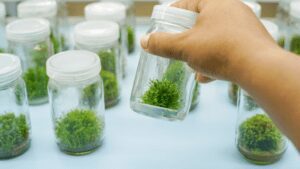
Primary metabolites
- Primary metabolites like carbohydrates, amino acids, peptides, and proteins can be found in all plants.
- They are responsible for basic physiological functions.
- Are indispensable for the life of each plant.
In short, the primary metabolites are the building blocks of the body of the plants. The following article is about primary metabolites and secondary metabolites and Primary metabolites vs secondary metabolites.
Secondary metabolites
- All types of plant-based products are nothing but the secretion of the plant’s secondary metabolites.
- The term “secondary” was introduced by Kossel (1891). Secondary metabolites in contrast to primary metabolites are present only incidentally and are not of paramount significance for plant life.
- In many cases, these substances serve as the molecules of plant defense against predation by microorganisms, insects, and herbivores.
- But for mankind, they are the major sources of natural products and are used as pharmaceuticals, agrochemicals, flavors and fragrances, ingredients, food additives, and pesticides.
- Secondary metabolites comprise more than 30,000 different chemical substances that are exclusively produced by plants and have been intensively studied for their medical effects on humans.
Secondary chemical compounds found in plants, such as alkaloids, flavonoids, and sterols, have specific effects on the human body and are used for medicinal purposes.
These compounds also have practical applications, including flavors, fragrances, biofuels, and cosmetics.
Plant cell cultures can produce the same valuable compounds as natural sources.
Overall, plant-based resources provide an array of useful compounds, including bioactive substances, natural pigments, and preservatives, which have been incorporated into commercial and industrial products.
Importance of tissue culture for the production of secondary metabolites

1. Production can be more reliable, simpler, and predictable.
2. Isolation of the phytochemical can be rapid and efficient, as compared to extraction from complex whole plants.
3. Compounds produced in vitro can directly parallel compounds in the whole plant.
4. Interfering compounds that occur in the field-grown plant can therefore be avoided in cell cultures.
5. Tissue and cell cultures can yield a source of defined standard phytochemicals in large volumes.
6. Tissue and cell cultures are a potential model to test elicitation.
7. Cell cultures can be radiolabeled, such that the accumulated secondary products, when provided as feed to laboratory animals, can be traced metabolically.
Plant cell culture provides an excellent platform for generating secondary products continuously and throughout the year without being constrained by seasonal variations.
The production process is reliable, predictable, and immune to changes in weather.
In some cases, the yield per gram of fresh weight obtained from plant cell culture can exceed that found in nature.
Political boundaries or geographical limitations are not an issue, making it a valuable alternative to the wild collection of rare or hard-to-find plant species.
The extraction of valuable compounds from plant cell culture tissues is a simpler process than from organized and complex tissues of plants. Hence, providing a more efficient approach to obtaining these products.
Moreover, the opportunity to manipulate the chemical or physical microenvironment within the plant tissue culture offers a unique opportunity to customize the chemical profile of the phytochemical product. Which may lead to producing compounds with higher potential value for human use.
Overall, plant tissue culture techniques are a promising approach to generating secondary products continuously. Tailoring the chemical profile of these products, and overcoming the challenges associated with traditional plant-based production methods.
